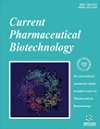- Home
- A-Z Publications
- Current Pharmaceutical Biotechnology
- Previous Issues
- Volume 25, Issue 2, 2024
Current Pharmaceutical Biotechnology - Volume 25, Issue 2, 2024
Volume 25, Issue 2, 2024
-
-
Dietary, Herbal and Nutritional Interventions for Managing Rheumatoid Arthritis: A Review
More LessAuthors: Aanchal Verma, Nandini Dubey, Anant Agrawal and Ahsas GoyalRheumatoid Arthritis (RA) is a systemic, inflammatory disease that affects joints and leads to progressive cartilage and bone deterioration. The susceptibility to RA is determined by genetic and environmental factors. Recently, many efforts have been undertaken to develop natural compounds capable of reducing the symptoms of RA to avoid the negative effects of the current anti-inflammatory drugs. Interestingly, Read More
-
-
-
TiO2 Nanoparticles in Cancer Therapy as Nanocarriers in Paclitaxel’s Delivery and Nanosensitizers in Phototherapies and/or Sonodynamic Therapy
More LessAuthors: Fernanda M.P. Tonelli, Flávia C.P. Tonelli and Helon G. CordeiroNanomaterials have been offering improvements in different areas due to their unique characteristics, but cytotoxicity associated with their use is still a topic that concerns researchers. Causing cell death, at first glance, may seem to be a problem and the studies regarding signaling pathways involved in this toxicity are still in their infancy. However, there are scenarios in which this feature is desirable, such as in cancer treatme Read More
-
-
-
Weapons and Strategies against COVID-19: A Perspective
More LessAuthors: Raghav Mishra, Kajal Chaudhary and Isha MishraCurrently, there are no approved treatments for the fatal infectious coronavirus disease. The process of identifying new applications for approved pharmaceuticals is called drug repurposing. It is a very successful strategy for drug development as it takes less time and cost to uncover a therapeutic agent than the de novo procedure. Severe Acute Respiratory Syndrome Coronavirus 2 (SARS-CoV-2) is the seventh coronavi Read More
-
-
-
Recent Updates on Transdermal Drug Delivery Approaches for the Management of Gout and its Clinical Perspective
More LessAuthors: Ranjit K. Harwansh, Soumya Mishra, Rupa Mazumder, Rohitas Deshmukh and Akhlaquer RahmanOral and injectable drug administration have recently been replaced with transdermal drug delivery (TDD) approaches, which are less intrusive, less likely to be rejected by patients, and easier to administer. There is still room for improvement in the treatment of gout with the use of a TDD system. Gout has become a worldwide epidemic and a severe threat to human beings. Gout treatment can be accomplished in various Read More
-
-
-
Herbal Medicines - A Fruitful Approach to Periodic Illness Dysmenorrhoea: Evidence-based Review
More LessAuthors: Keshav Bansal, Sachin Sharma and Meenakshi BajpaiDysmenorrhea (menstrual or periodic pain) is a discomfort that occurs during painful periods. It is the first and most prominent reason for female lower abdominal pain. Most adolescent girls consider it a curse due to the periodic occurrence of painful cramps and bleeding. The pathogenesis of painful periods is most likely because of increased prostanoids, notably prostaglandins, produced by the cyclooxygenase pathway (PGs). Read More
-
-
-
Therapeutic Potential of Ascorbic Acid in the Management of Alzheimer's Disease: An Update
More LessAuthors: Bhupesh C. Semwal, Bhoopendra Singh, Yogesh Murti and Sonia SinghBackground: Ascorbic acid is a potent natural antioxidant that protects against oxidative stress and performs various bodily functions. It is commonly found in fruits and vegetables. Objective: The manuscript has been written to provide valuable insights into ascorbic acid in managing Alzheimer's disease. Methods: The data has been gathered from web sources, including PubMed, Science Direct, Publons, Web of Scienc Read More
-
-
-
The Role of Monosodium Glutamate (MSG) in Epilepsy and other Neurodegenerative Diseases: Phytochemical-based Therapeutic Approa-ches and Mechanisms
More LessAuthors: Mansi Singh and Siva P. PandaEpilepsy is a common neurological disease affecting 50 million individuals worldwide, and some forms of epilepsy do not respond to available treatments. Overactivation of the glutamate pathway and excessive entrance of calcium ions into neurons are proposed as the biochemical mechanisms behind epileptic seizures. However, the overactivation of neurons has also been associated with other neurodegenerative d Read More
-
-
-
Characterization and Immunogenicity of Recombinant A. flavus Uox Modified by Co/EDTA Carbon Dots
More LessAuthors: Hai-Ling Li, Xiu-Feng Gao, Jing-Ji Li, Ming-Xia Wan, Guo-Qi Zhang and Yong-Sheng LiBackground: Uricase (Uox) is a major drug in gout and a supplementary drug in cancer treatment. Because allergic reactions caused by Uox limit its clinical application,10% Co/EDTA was used to chemically modify Uox from A. flavus to reduce its immunogenicity. Methods: The immunogenicity of Uox and 10% Co/EDTA-Uox was examined by determining the antibody titer and concentration of IL-2, IL-6, IL-10, and TNF-β in quail a Read More
-
Volumes & issues
-
Volume 26 (2025)
-
Volume 25 (2024)
-
Volume 24 (2023)
-
Volume 23 (2022)
-
Volume 22 (2021)
-
Volume 21 (2020)
-
Volume 20 (2019)
-
Volume 19 (2018)
-
Volume 18 (2017)
-
Volume 17 (2016)
-
Volume 16 (2015)
-
Volume 15 (2014)
-
Volume 14 (2013)
-
Volume 13 (2012)
-
Volume 12 (2011)
-
Volume 11 (2010)
-
Volume 10 (2009)
-
Volume 9 (2008)
-
Volume 8 (2007)
-
Volume 7 (2006)
-
Volume 6 (2005)
-
Volume 5 (2004)
-
Volume 4 (2003)
-
Volume 3 (2002)
-
Volume 2 (2001)
-
Volume 1 (2000)
Most Read This Month
Article
content/journals/cpb
Journal
10
5
false
en


